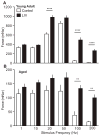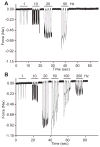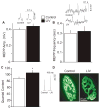Enhancement of neuromuscular dynamics and strength behavior using extremely low magnitude mechanical signals in mice
- PMID: 24157062
- PMCID: PMC3881264
- DOI: 10.1016/j.jbiomech.2013.09.024
Enhancement of neuromuscular dynamics and strength behavior using extremely low magnitude mechanical signals in mice
Abstract
Exercise in general, and mechanical signals in particular, help ameliorate the neuromuscular symptoms of aging and possibly other neurodegenerative disorders by enhancing muscle function. To better understand the salutary mechanisms of such physical stimuli, we evaluated the potential for low intensity mechanical signals to promote enhanced muscle dynamics. The effects of daily brief periods of low intensity vibration (LIV) on neuromuscular functions and behavioral correlates were assessed in mice. Physiological analysis revealed that LIV increased isometric force production in semitendinosus skeletal muscle. This effect was evident in both young and old mice. Isometric force recordings also showed that LIV reduced the fatiguing effects of intensive synaptic muscle stimulation. Furthermore, LIV increased evoked neurotransmitter release at neuromuscular synapses but had no effect on spontaneous end plate potential amplitude or frequency. In behavioral studies, LIV increased mouse grip strength and potentiated initial motor activity in a novel environment. These results provide evidence for the efficacy of LIV in producing changes in the neuromuscular system that translate into performance gains at a behavioral scale.
Keywords: Mechanical signals; Muscle strength; Neuromuscular; Quantal content; Whole body vibration.
© 2013 Published by Elsevier Ltd.
Conflict of interest statement
Clinton T. Rubin serves as Chief Scientific Officer for Marodyne Medical. All other authors have no conflict of interest, and all experiments were conducted independent of Dr. Rubin, who acted as an advisor and provided equipment for the LIV treatments.
Figures





Similar articles
-
Endurance exercise modulates neuromuscular junction of C57BL/6NNia aging mice.J Appl Physiol (1985). 1997 Jul;83(1):59-66. doi: 10.1152/jappl.1997.83.1.59. J Appl Physiol (1985). 1997. PMID: 9216945
-
Local low-intensity vibration improves healing of muscle injury in mice.Physiol Rep. 2020 Jan;8(2):e14356. doi: 10.14814/phy2.14356. Physiol Rep. 2020. PMID: 31981324 Free PMC article.
-
Motor unit and neuromuscular junction remodeling with aging.Curr Aging Sci. 2011 Dec;4(3):209-20. doi: 10.2174/1874609811104030209. Curr Aging Sci. 2011. PMID: 21529328 Review.
-
Prenatal hyperhomocysteinemia induces oxidative stress and accelerates 'aging' of mammalian neuromuscular synapses.Int J Dev Neurosci. 2019 Jun;75:1-12. doi: 10.1016/j.ijdevneu.2019.03.004. Epub 2019 Apr 1. Int J Dev Neurosci. 2019. PMID: 30946975
-
Age-related Changes in Motor Function (I). Mechanical and Neuromuscular Factors.Int J Sports Med. 2020 Oct;41(11):709-719. doi: 10.1055/a-1144-3408. Epub 2020 May 4. Int J Sports Med. 2020. PMID: 32365388 Review.
Cited by
-
Exploring the Revolutionary Impact of YAP Pathways on Physical and Rehabilitation Medicine.Biomolecules. 2025 Jan 10;15(1):96. doi: 10.3390/biom15010096. Biomolecules. 2025. PMID: 39858490 Free PMC article. Review.
-
Recovery of stem cell proliferation by low intensity vibration under simulated microgravity requires LINC complex.NPJ Microgravity. 2019 May 15;5:11. doi: 10.1038/s41526-019-0072-5. eCollection 2019. NPJ Microgravity. 2019. PMID: 31123701 Free PMC article.
-
The macroscopic and microscopic effect of low-frequency whole-body vibration after cerebral ischemia in rats.Metab Brain Dis. 2018 Feb;33(1):15-25. doi: 10.1007/s11011-017-0113-2. Epub 2017 Sep 25. Metab Brain Dis. 2018. PMID: 28948448
-
Whole Body Vibration Improves Spatial Memory, Anxiety-Like Behavior, and Motor Performance in Aged Male and Female Rats.Front Aging Neurosci. 2022 Jan 21;13:801828. doi: 10.3389/fnagi.2021.801828. eCollection 2021. Front Aging Neurosci. 2022. PMID: 35126091 Free PMC article.
-
Improvement in muscle performance after one-year cessation of low-magnitude high-frequency vibration in community elderly.J Musculoskelet Neuronal Interact. 2016 Mar;16(1):4-11. J Musculoskelet Neuronal Interact. 2016. PMID: 26944817 Free PMC article. Clinical Trial.
References
-
- Alonso I, Marques JM, Sousa N, Sequeiros J, Olsson IA, Silveira I. Motor and cognitive deficits in the heterozygous leaner mouse, a Cav2.1 voltage-gated Ca2+ channel mutant. Neurobiology of aging. 2008;29:1733–1743. - PubMed
-
- Bozzo C, Spolaore B, Toniolo L, Stevens L, Bastide B, Cieniewski-Bernard C, Fontana A, Mounier Y, Reggiani C. Nerve influence on myosin light chain phosphorylation in slow and fast skeletal muscles. The FEBS journal. 2005;272:5771–5785. - PubMed
Publication types
MeSH terms
Grants and funding
LinkOut - more resources
Full Text Sources
Other Literature Sources

